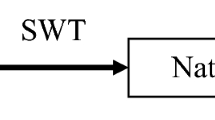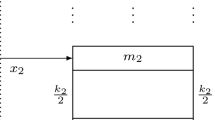Abstract
Structural vibration is critical in designing buildings and foundations for equipment. Planning for a smart city demands effective monitoring of the effects of seismic vibrations that will be possible to implement from a remote end. This paper tries to monitor seismic vibration from the top of a structure using wavelet decompositions. At first, vibrational drifts are obtained and then processed through multistep decompositions. Various coefficients obtained have been analysed by their statistical nature. Studies have been made for both open and closed loops with active mass addition. The percentage change of vibrational effect has been compared with the percentage change of coefficients at different decomposition steps by their mean and standard deviations. Thus, the study ends with some valuable indices for vibration monitoring.















Similar content being viewed by others
References
M. Saravanabalaji, N. Sivakumaran, S. Sankarnaraynan, Dynamic compensation of acoustic resonance for water flow system. J. Inst. Eng. India Ser. B 100, 405–415 (2019). https://doi.org/10.1007/s40031-019-00404-0
B.F. Spencer Jr., S.J. Dyke, H.S. Deoskar, Benchmark problems in strucural control: part I–active mass drive system. Earthq. Eng. Struct. Dyn. 27(11), 1127–1139 (1998)
A. Sabato, M.Q. Feng, Y. Fukuda, D.L. Carní, G. Fortino, A novel wireless accelerometer board for measuring low-frequency and low-amplitude structural vibration. IEEE Sens. J. 16(9), 2942–2949 (2016). https://doi.org/10.1109/JSEN.2016.2522940
F.A. Shirazi, J. Mohammadpour, K.M. Grigoriadis, G. Song, Identification and control of an MR damper with stiction effect and its application in structural vibration mitigation. IEEE Trans. Control Syst. Technol. 20(5), 1285–1301 (2012). https://doi.org/10.1109/TCST.2011.2164920
S.O.R. Moheimani, B.J.G. Vautier, Resonant control of structural vibration using charge-driven piezoelectric actuators. IEEE Trans. Control Syst. Technol. 13(6), 1021–1035 (2005). https://doi.org/10.1109/TCST.2005.857407
H. Gao, W. Zhan, H.R. Karimi, X. Yang, S. Yin, Allocation of actuators and sensors for coupled-adjacent-building vibration attenuation. IEEE Trans. Industr. Electron. 60(12), 5792–5801 (2013). https://doi.org/10.1109/TIE.2012.2233699
G. Jin, M.K. Sain, B.E. Spencer, Nonlinear blackbox modeling of MR-dampers for civil structural control. IEEE Trans. Control Syst. Technol. 13(3), 345–355 (2005). https://doi.org/10.1109/TCST.2004.841645
R. Subbaramaiah, S.A. Al-Jufout, A. Ahmed, M.M. Mozumdar, Design of vibration-sourced piezoelectric harvester for battery-powered smart road sensor systems. IEEE Sens. J. 20(23), 13940–13949 (2020). https://doi.org/10.1109/JSEN.2020.3000489
F. Duan, Z. Liu, Y. Song, S. Derosa, A. Rønnquist, D. Zhai, Vibration measurement and wave reflection analysis in an electrified railway catenary based on analytical methods. IEEE Trans. Instrum. Meas. 6503112, 1–12 (2021). https://doi.org/10.1109/TIM.2021.3063178
X. Li, W. Yu, S. Villegas, Structural health monitoring of building structures with online data mining methods. IEEE Syst. J. 10(3), 1291–1300 (2016). https://doi.org/10.1109/JSYST.2015.2481380
A.A. Savkar, K.D. Murphy, Z.C. Leseman, T.J. Mackin, M.R. Begley, On the use of structural vibrations to release stiction failed MEMS. J. Microelectromech. Syst. 16(1), 163–173 (2007). https://doi.org/10.1109/JMEMS.2006.885986
M. Hosek, N. Olgac, A single-step automatic tuning algorithm for the delayed resonator vibration absorber. IEEE/ASME Trans. Mechatron. 7(2), 245–255 (2002). https://doi.org/10.1109/TMECH.2002.1011261
B. Vysotskyi, F. Parrain, D. Aubry, P. Gaucher, X. Le Roux, E. Lefeuvre, Engineering the structural nonlinearity using multimodal-shaped springs in MEMS. J. Microelectromech. Syst. 27(1), 40–46 (2018). https://doi.org/10.1109/JMEMS.2017.2779179
Q. Wang, D. Wang, A reduced-order model about structural wave control based upon the concept of degree of controllability. IEEE Trans. Autom. Control 39(8), 1711–1713 (1994). https://doi.org/10.1109/9.310058
S. Jinachandran et al., Fabrication and characterization of a magnetized metal-encapsulated FBG sensor for structural health monitoring. IEEE Sens. J. 18(21), 8739–8746 (2018). https://doi.org/10.1109/JSEN.2018.2866803
P. Guo, X. Liu, S. Tang, J. Cao, Enabling coverage-preserving scheduling in wireless sensor networks for structural health monitoring. IEEE Trans. Comput. 65(8), 2456–2469 (2016). https://doi.org/10.1109/TC.2015.2485204
D.K. Ray, A. Rai, A.K. Khetan et al., Brush fault analysis for Indian DC traction locomotive using DWT-based multi-resolution analysis. J. Inst. Eng. India Ser. B 101, 335–345 (2020). https://doi.org/10.1007/s40031-020-00468-3
A. Di Gerlando, G. Foglia, R. Perini, Permanent magnet machines for modulated damping of seismic vibrations: electrical and thermal modeling. IEEE Trans. Industr. Electron. 55(10), 3602–3610 (2008). https://doi.org/10.1109/TIE.2008.928105
A.H. Khan, S. Li, Sliding mode control with PID sliding surface for active vibration damping of pneumatically actuated soft robots. IEEE Access 8, 88793–88800 (2020). https://doi.org/10.1109/ACCESS.2020.2992997
W. Gersch, D. Foutch, Least squares estimates of structural system parameters using covariance function data. IEEE Trans. Autom. Control 19(6), 898–903 (1974). https://doi.org/10.1109/TAC.1974.1100731
X. Chu, Z.X. Zhou, G.J. Deng, T.J. Jiang, Y.K. Lei, Study on damage identification of beam bridge based on characteristic curvature and improved wavelet threshold de-noising algorithm. Adv. Model. Anal. B 60(2), 498–516 (2017). https://doi.org/10.18280/ama_b.600217
Q. Xia, W.J. Qu, Y.Q. Li, J. Zhao, Analysis of natural vibration frequency of different support slabs under the traffic vibration based on field measurement. Instrum. Mesur. Métrol. 17(2), 219–233 (2018). https://doi.org/10.3166/I2M.17.219-233
S.A. Neilda, P.D. McFadden, M.S. Williams, A review of time-frequency methods for structural vibration analysis. Eng. Struct. 25, 713–728 (2003). https://doi.org/10.1016/S0141-0296(02)00194-3
S.S. Ghosh, S. Chattopadhyay, A. Das, Fast Fourier transform and wavelet-based statistical computation during fault in snubber circuit connected with robotic brushless direct current motor. Cogn. Comput. Syst. (2022). https://doi.org/10.1049/ccs2.12041
T.K. Das, S. Chattopadhyay, A. Das, Line to line short circuit fault diagnosis in photo-voltaic array based microgrid system. AMSE Measur. Control 90(4), 341–352 (2017). https://doi.org/10.18280/mmc_a.900403
N. Mukherjee, A. Chattopadhyaya, S. Chattopadhyay, S. Sengupta, Discrete-wavelet-transform and stockwell-transform-based statistical parameters estimation for fault analysis in grid-connected wind power system. IEEE Syst. J. 14(3), 4320–4328 (2020). https://doi.org/10.1109/JSYST.2020.2984132
A.M. Medhi, A.D. Patange, S.S. Pardeshi, R. Jegadeeshwaran, M. Kuntoglu, Overview of contemporary systems driven by open-design movement, arXiv:2201.05698v1 [cs.AR], https://doi.org/10.48550/arXiv.2201.05698
S.S. Patil, S.S. Pardeshi, N. Pradhan, A.D. Patange, Cutting tool condition monitoring using a deep learning-based artificial neural network. Int. J. Perform. Eng. 18(1), 37–46 (2022)
H.S. Khade, A.D. Patange, S.S. Pardeshi, R. Jegadeeshwaran, Design of bagged tree ensemble for carbide coated inserts fault diagnosis. Mater. Today Proc. 46, 1283–1289 (2021). https://doi.org/10.1016/j.matpr.2021.02.128
A. Khairnar, A. Patange, S. Pardeshi, R. Jegadeeshwaran, Supervision of carbide tool condition by training of vibration-based statistical model using boosted trees ensemble. Int. J. Perform. Eng. 17(2), 229–240 (2021). https://doi.org/10.23940/ijpe.21.02.p7.229240
N.S. Bajaj, A.D. Patange, R. Jegadeeshwaran, K.A. Kulkarni, R.S. Ghatpande, A.M. Kapadnis, A bayesian optimized discriminant analysis model for condition monitoring of face milling cutter using vibration datasets. ASME J. Nondestruct. Eval. 5(2), 021002 (2021)
A.D. Patange, R. Jegadeeshwaran, N.S. Bajaj, A.N. Khairnar, N.A. Gavade, Application of machine learning for tool condition monitoring in turning. Sound Vib. 56(2), 127–145 (2022). https://doi.org/10.32604/sv.2022.014910
T.Y. Deo, A.D. Patange, S.S. Pardeshi, R. Jegadeeshwaran, A.N. Khairnar, H.S. Khade, A white-box SVM framework and its swarm-based optimization for supervision of toothed milling cutter through characterization of spindle vibrations, arXiv:2112.08421v1 [cs.LG], https://doi.org/10.48550/arXiv.2112.08421
A.D. Patange, R. Jegadeeshwaran, Application of bayesian family classifiers for cutting tool inserts health monitoring on CNC milling. Int. J. Progn. Health Manag. (2020). https://doi.org/10.36001/ijphm.2020.v11i2.2929
A.D. Patange, R. Jegadeeshwaran, A machine learning approach for vibration-based multipoint tool insert health prediction on vertical machining centre (VMC). Measurement (2021). https://doi.org/10.1016/j.measurement.2020.108649
Author information
Authors and Affiliations
Corresponding author
Ethics declarations
Conflict of interest
The authors declare that they have no known competing financial interests or personal relationships that could have appeared to influence the work reported in this paper.
Additional information
Publisher's Note
Springer Nature remains neutral with regard to jurisdictional claims in published maps and institutional affiliations.
Rights and permissions
Springer Nature or its licensor holds exclusive rights to this article under a publishing agreement with the author(s) or other rightsholder(s); author self-archiving of the accepted manuscript version of this article is solely governed by the terms of such publishing agreement and applicable law.
About this article
Cite this article
Das, A., Chattopadhyay, S. Structural Seismic Vibration Analysis Using Multistep Wavelet Decomposition. J. Inst. Eng. India Ser. B 103, 2135–2143 (2022). https://doi.org/10.1007/s40031-022-00794-8
Received:
Accepted:
Published:
Issue Date:
DOI: https://doi.org/10.1007/s40031-022-00794-8




